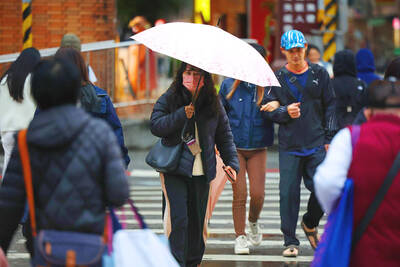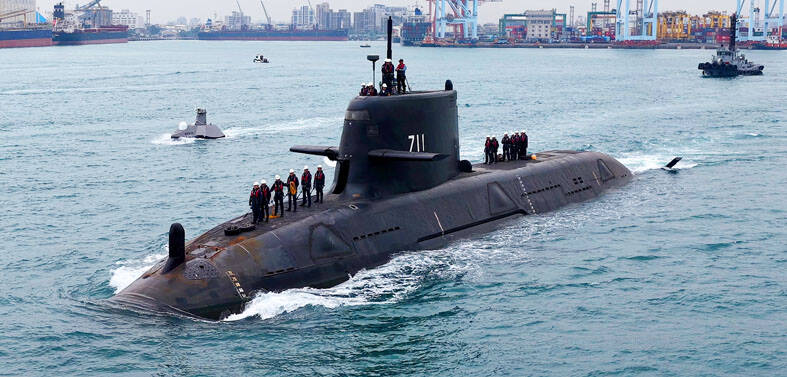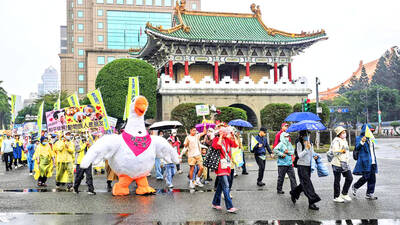The “1922” short message service (SMS) is only used for contact tracing to curb the spread of COVID-19 and has never been used in criminal investigations, the National Communications Commission (NCC) said on Sunday.
The commission issued the statement after the Legislative Yuan on Friday reduced the subsidies that the commission budgeted to partially fund telecoms in maintaining their messaging service systems from NT$800 million (US$28.623 million) to NT$300 million.
On Saturday, the Chinese-language United Daily News published a letter written by Taichung District Court Judge Chang Yuan-sen (張淵森), who accused the Criminal Investigation Bureau of using the 1922 service to track suspects, citing an application for a search warrant he had reviewed.

Photo courtesy of the Taipei City Government via CNA
The commission said in the statement that information gathered through the 1922 service is only used for “disease prevention purposes,” meaning that only the Central Epidemic Command Center (CECC) can request access to the data.
The bureau has never requested the center’s permission to access the data, it said.
“Except for the CECC, telecoms have never offered such data to other third parties. The government has been keeping its word about how data should be used,” it added.
The Communication Security and Surveillance Act (通訊保障及監察法) stipulates that a district judge may issue an interception warrant if there is sufficient evidence that an accused or a suspect has been involved in criminal activity, and that it is reasonable to assume that the content of their communications is relevant to the case being investigated.
The warrant allows police to view or listen to communication records of suspects, including text messages sent to the 1922 hotline, the commission said.
“The communication surveillance system is regulated by the Communication Security and Surveillance Act, whereas data collected by 1922 messaging service are used by CECC to track the spread of coronavirus. The two systems are established using different regulations, setting different purposes and scopes for data gathering,” it said.
“It is regrettable that the judge made a commentary without first discerning different regulations governing access to the two systems,” it said.
Deputy Minister of the Interior Chen Tsung-yen (陳宗彥), who is a deputy head of the center, said that they have reminded police stations nationwide that they should exclude 1922 messages from criminal investigations.
The service activates the text-messaging function for the 1922 hotline, which was established by the Centers for Disease Control for people to ask questions about COVID-19 or other communicable diseases.
Regarding the budget cut for messaging services, the commission said text messages are delivered to the 1922 hotline free of charge.
As of Monday last week, more than 390 million messages had been sent to 1922, the commission said.
The subsidies would be used to help telecoms expand the capacity of their text-messaging systems to store messages and process the CECC’s contact tracing requests, the commission said.
The money spent by telecoms to maintain the systems is much more than the subsidies.
The Executive Yuan launched 1922’s messaging service on May 19, when the government issued a nationwide level 3 COVID-19 alert. Under the alert, businesses and restaurants must record customers’ names and telephone numbers, as well as the number of accompanying visitors, for contact tracing.
Businesses and restaurants need to obtain a QR code by registering on the e-Mask pre-order system (emask.taiwan.gov.tw/real) and place the code in their venues.
When entering a store or a restaurant, people need to scan the code using a smartphone and follow a prompt that appears on the screen to send a message to the 1922 hotline.
Telecoms must delete the messages from their systems after 28 days.

NUMBERS IMBALANCE: More than 4 million Taiwanese have visited China this year, while only about half a million Chinese have visited here Beijing has yet to respond to Taiwan’s requests for negotiation over matters related to the recovery of cross-strait tourism, the Tourism Administration said yesterday. Taiwan’s tourism authority issued the statement after Chinese-language daily the China Times reported yesterday that the government’s policy of banning group tours to China does not stop Taiwanese from visiting the country. As of October, more than 4.2 million had traveled to China this year, exceeding last year. Beijing estimated the number of Taiwanese tourists in China could reach 4.5 million this year. By contrast, only 500,000 Chinese tourists are expected in Taiwan, the report said. The report

Temperatures are forecast to drop steadily as a continental cold air mass moves across Taiwan, with some areas also likely to see heavy rainfall, the Central Weather Administration (CWA) said. From today through early tomorrow, a cold air mass would keep temperatures low across central and northern Taiwan, and the eastern half of Taiwan proper, with isolated brief showers forecast along Keelung’s north coast, Taipei and New Taipei City’s mountainous areas and eastern Taiwan, it said. Lows of 11°C to 15°C are forecast in central and northern Taiwan, Yilan County, and the outlying Kinmen and Lienchiang (Matsu) counties, and 14°C to 17°C

STEERING FAILURE: The first boat of its class is experiencing teething issues as it readies for acceptance by the navy, according to a recent story about rudder failure The Hai Kun (海鯤), the nation’s first locally built submarine, allegedly suffered a total failure of stern hydraulic systems during the second round of sea acceptance trials on June 26, and sailors were forced to manually operate the X-rudder to turn the submarine and return to port, news Web site Mirror Daily reported yesterday. The report said that tugboats following the Hai Kun assisted the submarine in avoiding collisions with other ships due to the X-rudder malfunctioning. At the time of the report, the submarine had completed its trials and was scheduled to begin diving and surfacing tests in shallow areas. The X-rudder,

DEMAND: The government should enact regulations in line with Austria and Germany to incorporate vegan nutrition into school meals, an advocate said More than 1,000 people yesterday marched in Taipei to promote veganism, calling for legislation to incorporate vegan diets into school lunches and the national net zero emissions program. Participants gathered on Ketagalan Boulevard in front of the Presidential Office Building for the march, which was organized by the Vegan Action Network (VAN). Former ambassador to Chad Chiu Chung-jen (邱仲仁), actor Yankee Yang (楊子儀) and actress Cindy Lien (連俞涵) attended the event. VAN member Marianne Chao (趙梅君) said that the campaign aimed to urge the government to promote vegan diets across schools and government agencies via legislation and national policies, which would help build